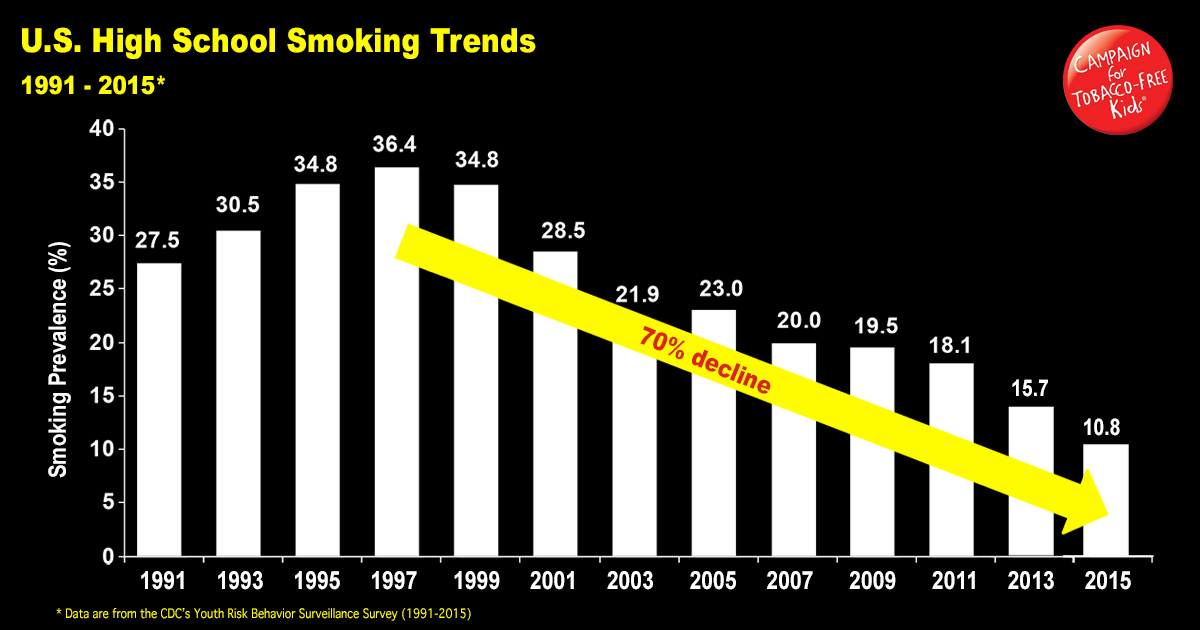Historic Decline in Youth Smoking Is Terrific News, but High Rate of E-Cigarette Use Must Be Addressed
Statement of Matthew L. Myers, President, Campaign for Tobacco-Free Kids
June 09, 2016
WASHINGTON, D.C. – The historic decline in youth cigarette smoking reported today by the Centers for Disease Control and Prevention (CDC) will save millions of lives in the years to come. According to the CDC’s 2015 Youth Risk Behavior Survey (YRBS), the smoking rate among high school students fell to a record-low 10.8 percent in 2015, down from 15.7 percent in 2013. The high school smoking rate has declined by 31 percent in just two years and by 70 percent since peaking at 36.4 percent in 1997.
The dramatic decline in youth smoking is a public health success story of extraordinary importance because cigarette smoking is the leading cause of preventable death in our country and kills nearly half a million Americans every year. However, this survey also raises fresh concerns that other tobacco products, especially electronic cigarettes and cigars, are undermining overall efforts to reduce youth tobacco use and could be luring a new generation of kids into nicotine addiction. Specific survey findings include:
E-cigarettes (called electronic vapor products in the survey): A shocking 24.1 percent of high school students were current (past-month) users of e-cigarettes in 2015, the highest rate in any government survey to date (2015 is the first year the YRBS asked about e-cigarette use, but other surveys have shown that youth e-cigarette use has skyrocketed in recent years).
Cigars: High school boys now smoke cigars at a higher rate than cigarettes – 14 percent for cigars and 11.8 percent for cigarettes. Altogether, 16 percent of high school students, including 19 percent of high school boys, reported smoking cigarettes or cigars.
Any tobacco use: 31.4 percent of high school students reported using some form of tobacco in the past month, including cigarettes, smokeless tobacco, cigars or e-cigarettes. It is unacceptable that nearly a third of high school students use some form of tobacco, showing that we must step up efforts to prevent youth use of all tobacco products.
These results show why the Food and Drug Administration (FDA) must effectively enforce and strengthen the new rules for e-cigarettes and cigars it announced in May – and why Congress must reject the two industry-motivated efforts to weaken the FDA’s authority.
The House appropriations bill that funds the FDA contains two provisions that would dramatically weaken the FDA’s authority to protect our kids. One provision exempts so-called “large and premium cigars,” but defines such cigars so broadly that it could also exempt some cheap, machine-made, flavored cigars that are widely used by children. The second provision limits FDA oversight of e-cigarettes and cigars already on the market, including the many candy-flavored products introduced in recent years. These proposals would make it easier for tobacco companies to keep targeting our children, which is the last thing we need in light of today’s survey results.
It is also critical that the FDA quickly issue follow-up regulations prohibiting the use of flavors – including candy, fruit and menthol flavors – in e-cigarettes and cigars. E-cigarettes and cigars are sold in an array of kid-friendly flavors such as gummy bear, cotton candy and fruit punch, and the FDA’s own research shows these flavors play a key role in the popularity of these products among kids. The FDA proposed removing such flavored products from the market in the rule it submitted to the White House Office of Management and Budget for review, but OMB deleted this provision from the final rule issued on May 5, as revealed by recently released government documents. This inexplicable action must be reversed.
While the fight against tobacco is far from over, the huge drop in youth cigarette smoking leaves no doubt we can win this fight by fully implementing what we know works. These results underscore the effectiveness of evidence-based strategies that have been implemented at the federal, state and local levels, including the strong actions the Obama Administration has taken since 2009 to revitalize the nation’s fight against tobacco.
After stalling for several years, smoking rates began falling again after the federal cigarette tax was increased by 62 cents in 2009. A landmark 2009 law gave the FDA authority over tobacco products and cracked down on tobacco marketing and sales to kids. In recent years, the CDC, the FDA and Truth Initiative have conducted the strongest and most sustained media campaigns to reduce tobacco use in the nation’s history.
States and localities have increased tobacco taxes, enacted smoke-free air laws and, in some cases, funded effective tobacco prevention and cessation programs, including mass media campaigns. California, Hawaii and over 145 cities and counties have raised the tobacco sale age to 21 (California’s law takes effect today).
Despite our progress, we cannot let up because tobacco use still kills more than 480,000 Americans and costs us about $170 billion a year in health care bills. It is within our reach to win this fight and make the next generation tobacco-free, but only if we have the political will to finish the job.


